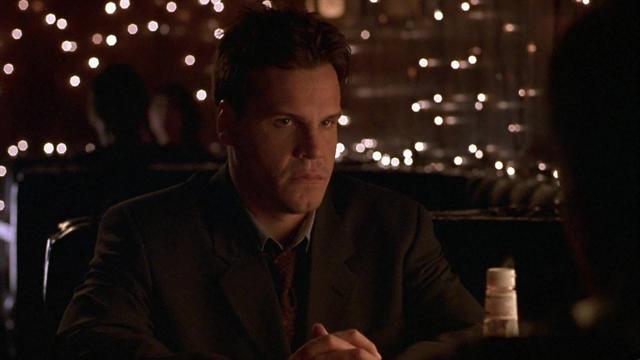After films that perform abysmally at the box office, very rarely do franchises survive later on. And this doesn't always mean sequels either. Sometimes films fail right at the start before things get going. Sequels on the other hand are reminders that if a franchise is not taken care of, the critical reception will tend to dip. For Clive Barker's Hellraiser (1987) series, the final theatrical nail in the coffin was Hellraiser IV: Bloodline (1996). With a troubled production of studio interference, inconsistent direction, poor critical and financial reception, it was finally time for the series to enter the home video market. Although the home video market is considered to be films of lesser quality, there tend to be the occasional surprise here and then. Five years later, it seems to have stepped up. This doesn't mean it blows all expectations away, but there are differences between this entry and Hellraiser III: Hell on Earth (1992) and Hellraiser IV: Bloodline (1996).
 |
| Craig Sheffer |
Sitting in the director's chair for this release was Scott Derrickson in his first long running movie. Derrickson also worked as the writer along with another usual associate being Paul Harris Boardman. Boardman also wrote for The Exorcism of Emily Rose (2005) and Deliver Us From Evil (2014). The story here is much more peculiar than previous entries. Joseph Thorne (Craig Sheffer), a seasoned detective is on the trail of a serial killer whom his first victim opened the Lament Configuration and left a child's finger behind. Hoping to find the child before it's too late, Thorne and his partner Tony (Nicholas Turturro) dig deeper. Unfortunately as the two continue searching for answers, Thorne begins heading down a path only he can travel. The premise itself is quite good actually, but there are other issues. The most noticeable flaw is that this movie makes no attempt to connect this one to any of the previous films in any way. That also doesn't mean forcefully inserting references but the story could have lead to areas of past events.
Along with that is the amount of time that focuses on Pinhead (Doug Bradley) and his fellow cenobite followers. The plot is more of a horror thriller with a smattering of cenobite flavor. Who doesn't want to see more cenobites? As for detective Thorne, his motivations seem to contradict his actions. He gives reasons as to why he makes certain decisions, but not all of it is clear. Thorne has a wife (Noelle Evans) and daughter, yet sleeps with a hooker (Sasha Barrese). There was no sign of his marriage in trouble to begin with so what gives? However for the story, those are the prominent issues. Even with its writing related problems, the whole mystery killer plot is gravitating. On top of that, the end result produces a moral lesson involved with deeper meanings that reference other films like Bill Murray's Groundhog Day (1993). As for characters of significance, Thorne is of main focus. His partner does receive some attention but over time he's dropped. There's also a psychologist played by James Remar that adds some depth to the story.
Although Craig Sheffer's role isn't totally clear, his ability to convey the right emotion is acceptable. Considering he also was in Clive Barker's Nightbreed (1990) a full decade earlier, it feels all the more appropriate. Doug Bradley as Pinhead continues to have all the memorable lines especially towards the finale. The following cenobites such as the Wire Twins and the Chattering Torso all have their moments of grotesqueness and work effectively in being scary. For a budget of only $2 million and being a home video release, the special and practical effects look fairly decent. Even the horror end of things look credible. The gore and violence used throughout isn't always shown on screen but there's still a lot of blood spilled throughout the running time. The devices used for these violent depictions are what you would expect from a Hellraiser film - hooks. Except these hooks are little more practical in their use. Instead of them hanging from the ceiling majority of the time, now they're used as a flail. Ouch.
 |
| "Uhhh well this is new..." |
Working as the cinematographer was Nathan Hope. Mostly having experience in the small screen, Nathan Hope has done a few big screen productions like this one, Mimic 2(2001) and The Fog (2005) remake. By far though, his most recognizable expertise shines through on the crime show CSI: Crime Scene Investigation from 2003 to 2007. For this movie, Hope's camerawork is still for 80%, but gets shakier near the finale. Thankfully the one technique that Hope avoids that previous DP Gerry Lively used were wide-angle lens shots. Those felt unnecessary. Composing the film score to this sequel was Walter Werzowa. Impressively Werzowa created a score with an hour full of music. The music itself sadly no longer has any main theme close to Christopher Young's but Werzowa makes new ones. Plus, the sound mostly consists of organic orchestra featuring strong deep strings and massive pipe organ cues. Seriously though, who uses pipe organs in their film scores anymore? That's one of the best parts and the score also contains very little jump stings.
Script wise the characters still lack clarity in motivations and connections to the previous films. Also the cenobites don't feel utilized to their potential. Yet somehow this sequel is better than the last two with a more intriguing premise, decent effects, believable acting and appropriate music.
Points Earned --> 6:10


No comments:
Post a Comment